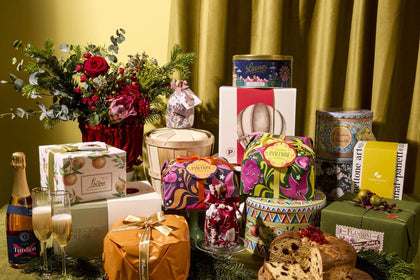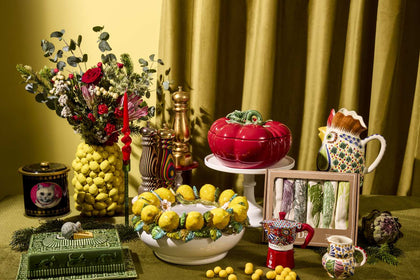Susan Jung On Fried Chicken From Around The World

"A hymn to the joys of fried chicken, with irresistible recipes and invaluable cooking tips. If you don’t already love eating fried chicken as much as Susan Jung does, you will after cooking from this book." – Fuchsia Dunlop
Susan Yung's book Kung Pao & Beyond showcases 60 fried chicken recipes from around the world. Whether it’s Korean Fire Chicken, Vietnamese Butter Wings, or Japanese Karaage, nothing surpasses the unique twists and flavours that cooks in East and Southeast Asia have brought to fried chicken.
Here, she tells us what she keeps in her kitchen and where she finds inspiration.
Kung Pao & Beyond by Susan Jung (Quadrille, £20), Photography by Yuki Sugiura
What's the best thing you’ve eaten recently?
Sizzling sisig. It's a Filipino dish that's usually eaten as a bar snack, and it's made of pig off-cuts, like the head, ears, skin and snout, so it has lots of texture. All the ingredients, which can be leftovers from lechon - whole roasted baby pig - are finely chopped before being cooked with garlic, onion and chilli, then the sisig is served on a hot iron plate so it's sizzling hot. I had it during an eight hour layover at the airport in Manila after a week of intensive eating in Singapore, when I'd been going out for absolutely incredible food, cooked by amazing chefs, every day for lunch and dinner. Although I loved all of those meals, by the end of the week I just wanted to eat something familiar, so the sisig was especially delicious.
What ingredients are always stocked in your pantry?
Of course, I keep everyday basics such as soy sauce, rice wine, fish sauce and sesame oil. But ingredients that some people might find surprising include instant noodles, which I absolutely love. There are many exceptions, but in general, when it comes to instant noodles, higher price equals better quality. I also have pork belly - I keep individually-wrapped thick-cut slices in my freezer so I can pull out a piece as I need it, thaw it in hot water, and use it for all kinds of Chinese and Korean dishes that I cook for my lunches.
I always have soft or firm tofu, to make into mapo tofu, cold beancurd with soy sauce and spring onions, or Korean chigaes - soupy stews - including kimchi chigae, soondubu chigae [soft beancurd stew] or doenjang chigae [fermented bean paste stew]. I am never without Korean and Japanese soup bags.
These are great - you just plop one in a cup of boiling water and let it stand for a few minutes to extract the flavour, then use it in dishes to add a good dose of umami. I love canned sardines, and have enough of these to keep me fed in case of a zombie apocalypse. Canned sardines are incredibly versatile, and I make sardine pasta, sardines on toast, sardine curry puffs, sardines cooked with tomatoes, sardine fried rice...
MORE: Browse all Korean food and ingredients

What are the components of a fantastic meal for you?
I used to think a great meal was just about the food. I often travel alone, and plan my trips around meals. Dining alone means you can concentrate on the food, without any distractions. I don't mind eating alone - even at formal restaurants, but now I prefer to eat a great meal with really good friends, or even with potential friends.
You can find out a lot about people when you eat with them. If they're awful to wait staff, then you don't want to be friends with them. If you're at a great restaurant and all they order is a green salad with dressing on the side, you probably don't want to be friends with them. But if your friends - or potential friends - eat delicious food with the same enthusiasm that you do, then it makes the meal even better.
What makes a great comfort dish for you?
I love soupy things, with rice or noodles. A good bowl of wonton noodle soup, or congee, or if I feel like eating something spicy I'll have Korean chigae. If I'm feeling under the weather, I like to have Hainan chicken rice, because it's so soothing - poached chicken with rice and a bowl of broth on the side.
What is one kitchen tip everyone should know?
The importance of salt and fat. I think many home cooks under-use both. They add just the tiniest pinch of salt, or the tiniest amount of fat, when both ingredients should be used more liberally. I'm not saying you should over-salt or add too much fat, but you should add enough - and "enough" is probably more than you think it should be. If enough salt is used, the food won't taste salty, it will just taste right.
What is one recipe everyone should try from the book?
The chicken poppers with instant noodle coating. Almost all the recipes in Kung Pao & Beyond are easy, but this is the easiest. You just dip the chicken in flour, egg, a coating made of instant noodles that have been ground with the seasoning mix in a food processor, and then you fry the pieces. The chicken is very crunchy, and you can change the flavour by using different types of instant noodles.
What will surprise people in your book?
The breadth and scope of fried chicken dishes from East and Southeast Asia. People have asked me, "Are there really that many fried chicken dishes from East and Southeast Asia?" and actually, there are more that I could have included. The ingredient palette in this part of the world is so varied, and the ingredients can be combined in so many ways.
Where do you find inspiration?
From eating! I love to taste new-to-me dishes and ingredients when I travel. On a one-week trip to Tokyo, I tasted two fried chickens that I wish I had included in the book. One was Famichiki - the fried chicken sold at the Family Mart convenience stores, and the other is the fried chicken from Maison Marunouchi at the Four Seasons Marunouchi.
Back in Hong Kong, I went to an izakaya called Uza by Nikushou, where I ate chicken karaage with Sichuan mala [numbing and spicy] chicken liver sauce. I have a recipe for chicken karaage in the book, but Uza's sauce took the dish to another level, and it made me wish I had given a few recipes for sauces.
How do you source your ingredients and what do you look for when selecting them?
When I was testing recipes for Kung Pao & Beyond, if I was using a whole bird, I'd get it from a poultry vendor. Hong Kong has really delicious fresh chickens, and they range in price from about HK$70 to HK$350. The expensive birds are a breed called Three Yellow chickens - the "three yellow" refers to the colour of the feathers, beak and feet, and most of the top chefs in Hong Kong use them.
I buy the cheaper chickens, and they're still very good. They're quite small - only 1.2kg, and they don't have overly large breasts, unlike the type you find in the US.
If I'm using chicken parts - which most of the recipes call for - I use frozen chicken. People might criticise me for that, but I can't tell readers to only buy "organic, free-range chickens" because in some countries, these birds are very expensive, and not everyone can afford them. I tell the readers to buy what they can afford.
For fresh ingredients, you get the best stuff from the wet markets. I love to go to these markets because they're so vibrant, and the prices are reasonable. You get amazing ginger and all types of chillies, and delicious small Asian cucumbers, and small tomatoes that are so sweet I can eat a whole bowlful, just plain. This type of tomato is sold from fruit vendors, while the larger type used for cooking is sold by the vegetable vendor.
If you go to the Thai markets in certain areas of Hong Kong, you can find really great produce from Thailand - lemongrass and lime leaf, Thai limes, which are small but very juicy, really sweet pineapples, luscious custard apples, and oranges that have green skin but bright orange flesh, which make the best orange juice. I love shopping in the wet markets - there's so much to see, and it really makes you want to take it all home and cook.



